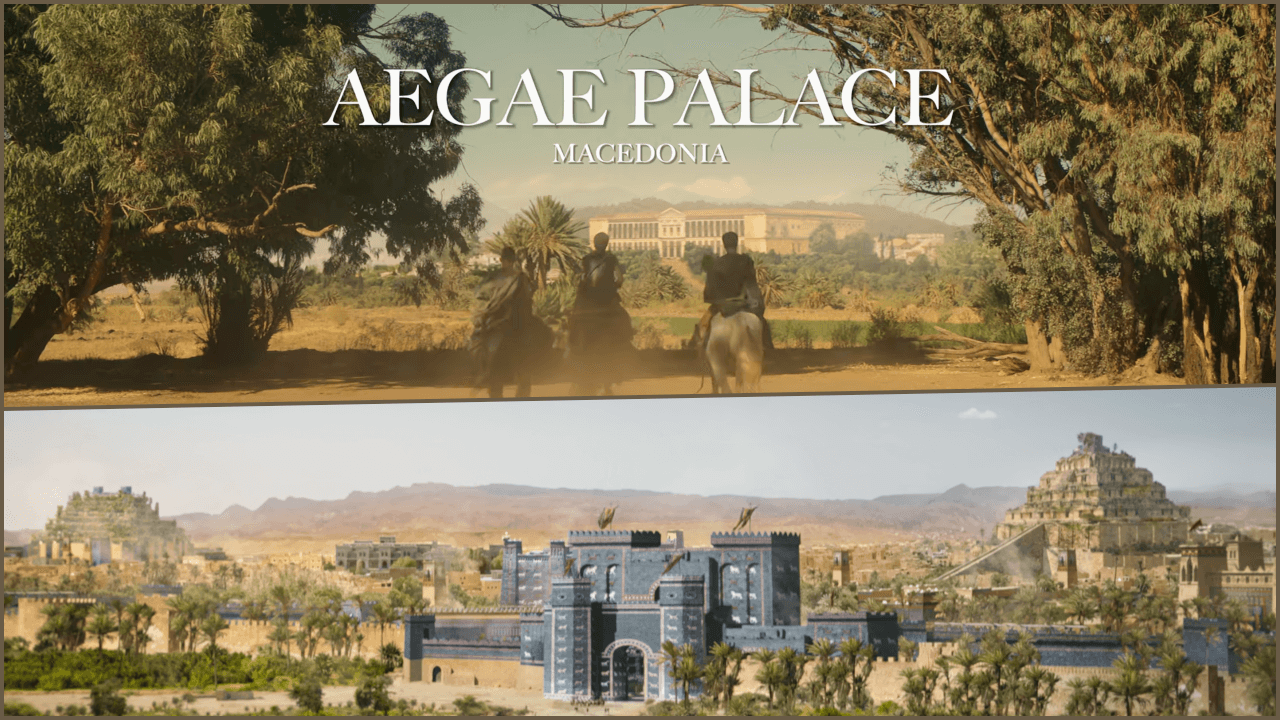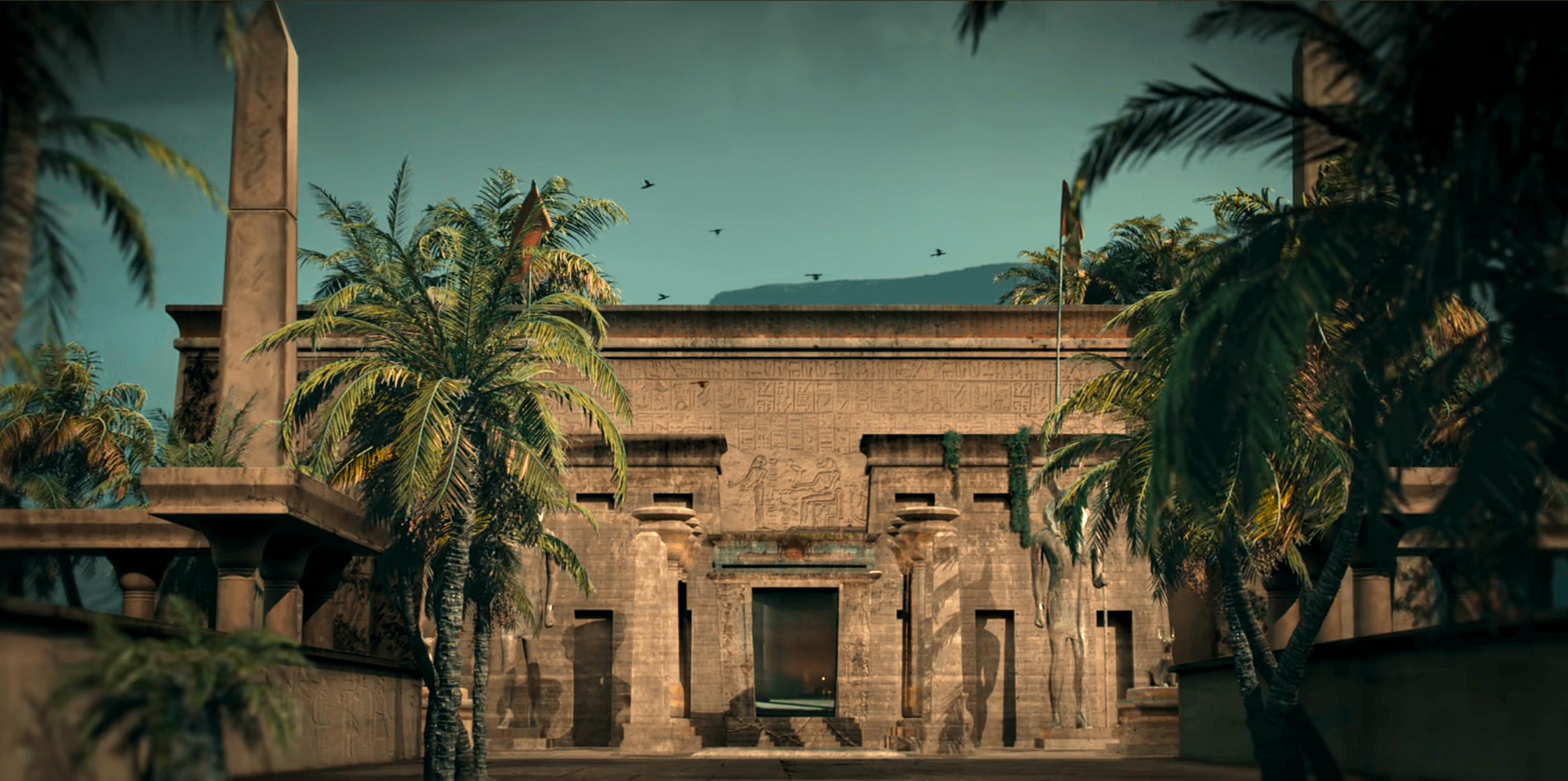The Netflix series "Alexander: The Making of a God" serves not only as a vivid recount of Alexander the Great's conquests but also as a visual spectacle that brings to life some of the most significant ancient sites across his empire. Through meticulous representation and the latest archaeological findings, viewers are transported to an era of unparalleled historical importance. Let’s delve into the significance and marvels of these ancient sites, as represented in the series.
The AigaE Palace in Macedonia
Image from: Netflix
The ancient site of the Aegae or Aigai Palace, situated in the heart of Macedonia, stands as a testament to the grandeur of ancient Greek civilization. This architectural masterpiece was the royal residence of the Macedonian kings and holds a special place in history as the birthplace of Alexander the Great. The palace's significance extends beyond its historical occupants; it is a marvel of ancient architecture, showcasing intricate designs and sophisticated construction techniques of the era.
Image from: Netflix
Thanks to the relentless efforts of Greek archaeologists and conservators, the Aigae Palace has undergone significant reconstruction in recent years. These endeavors have breathed new life into the site, allowing visitors and scholars alike to appreciate its historical context and architectural brilliance. The reconstruction work is a prime example of how modern technology and traditional techniques can come together to preserve our global heritage.
The City of Babylon
Image from: Netflix
The representation of Babylon in "Alexandros" is nothing short of breathtaking. The ancient city, known for its architectural marvels, is showcased in its full glory, with the Ishtar Gate and the Hanging Gardens taking center stage. Babylon was not only a cultural and economic hub but also a symbol of the Persian Empire's might, especially under Darius III in the 4th century BC.
The Ishtar Gate, adorned with images of dragons and bulls, served as a grand entrance to the city, reflecting the wealth and power of Babylon. The Hanging Gardens, one of the Seven Wonders of the Ancient World, remain shrouded in mystery, with their exact location and construction method still debated among historians. However, their representation in the series captures the imagination, portraying an oasis of lush vegetation suspended in the air.
For Darius III and the Persian Empire, Babylon was a strategic and ceremonial center. Its architectural splendor and economic prosperity showcased the empire's dominance and sophistication. The city's capture by Alexander the Great marked a significant turning point in ancient history, symbolizing the shift of power from the Persians to the Greeks.
Pelusium: The Gateway to Egypt
Image from: Netflix
The scene of Alexander's army outside the walls of Pelusium highlights the city's strategic importance at the Egyptian-Arab border. In 333 BC, Pelusium was not just a wealthy settlement but a crucial military and economic gateway into Egypt. Its capture by Alexander was a calculated move, securing a vital supply route and contributing significantly to his treasury.
The city's wealth, derived from its location on a now-shifted branch of the Nile, was instrumental in supporting Alexander's campaign. Pelusium's surrender marked the beginning of Alexander's conquest of Egypt, paving the way for his eventual coronation as pharaoh in Memphis.
Memphis: Alexander's Coronation as Pharaoh
Image from: Netflix
Memphis, once the capital of ancient Egypt, played a pivotal role in Alexander's journey. The series captures the moment of his coronation as pharaoh, an event that solidified his rule over Egypt and marked a significant milestone in his campaign. As pharaoh, Alexander adopted the traditions and customs of the Egyptians, integrating them into his empire and ensuring the loyalty of his Egyptian subjects.
Memphis, once the heart of ancient Egypt, held a position of unparalleled significance throughout much of Egyptian history. Founded around 3100 BC by King Menes, who is credited with uniting Upper and Lower Egypt, Memphis served as the capital of the Old Kingdom and remained an important cultural, religious, and political center for thousands of years. Strategically located at the apex of the Nile River Delta, it was a vital junction between the fertile agricultural lands of the delta and the desert trade routes. Memphis was also the seat of Ptah, the patron god of craftsmen, whose worship underscored the city's role as a hub of art, architecture, and creativity.
Image from: Netflix
As the place where pharaohs were crowned and served as a nexus of administrative and economic activity, Memphis symbolized the political unity and cultural prowess of ancient Egypt. Even after its decline as a political capital, Memphis continued to be revered for its religious significance, housing temples and monuments that attracted pilgrims and scholars. The remnants of this once-thriving metropolis, including the nearby pyramids of Giza and the sprawling necropolis of Saqqara, offer invaluable insights into ancient Egyptian civilization and its enduring legacy.
The Siwa Oasis and the Temple of Amun
Image from: Netflix
The mysterious visit of Alexander to the Siwa Oasis, home to the oracle of Ammon, is a moment of profound significance in the series. This event, shrouded in mystery, signifies Alexander's deep engagement with the divine and the local cultures he encountered. The portrayal of the Siwa Oasis and the Temple of Amun in "Alexandros" captures the mystique and spiritual importance of this site, highlighting Alexander's quest for divine approval and legitimacy.
Image from: Netflix
The significance of the Siwa Oasis and its oracle lies not only in the historical figures it attracted but also in the profound influence it held over the Greco-Roman world. Believed to be a direct link to the divine, the oracle's pronouncements could shape the destinies of leaders and nations. The oasis itself, a verdant haven in a vast desert, symbolized fertility and life in the midst of barrenness, serving as a focal point for the amalgamation of Egyptian and Greek cultures.
Image from: Netflix
The oracle's affirmation of Alexander as the son of Zeus-Ammon not only solidified his divine status among his followers but also exemplified the deep connections between politics, religion, and power in the ancient world. Today, the ruins of the temple stand as a testament to the enduring fascination with the divine and the lengths to which individuals will go to seek its counsel.
The Discovery in Alexandria
The series concludes with a groundbreaking archaeological discovery in Alexandria, believed to be connected to Alexander's final resting place. The efforts of Greek archaeologist Calliope Limneos-Papakosta and her team, battling against the elements to uncover layers of history, represent the pinnacle of archaeological dedication. The uncovering of an enormous public building and the first roads of Alexandria offers a tantalizing glimpse into the past and the enduring mystery of Alexander's tomb.
Image from: Netflix
"Alexander: The Making of a God" offers viewers more than just a recount of historical events; it provides a window into the past, showcasing the architectural and cultural marvels of Alexander the Great's empire. Through the lens of modern archaeology and reconstruction, the series brings to life the ancient world, allowing us to appreciate the complexities and achievements of one of history's most remarkable figures and the civilizations he touched.

















